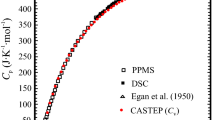Abstract
A new model for the location and distribution of carbonate ions in carbonated apatite was used to assign the IR spectra of A- and AB-carbonated apatites. The percentage of total carbonate as measured by the mass loss in the TGA of these compounds is in good agreement with the percentage obtained by combustion analysis. The decomposition of pure A-type carbonate appears at temperatures of 985–1123 °C, whereas the decomposition of AB-type carbonated apatites occurs in the range of 600–800 °C. This difference is attributed to changes in the environment of channel carbonate brought about by B-type substitution of carbonate for phosphate. In the presence of sodium ions, the channel is changed by substitution of sodium for calcium in order to accommodate the difference between the charge of the carbonate and phosphate ions. A thermodynamic cycle is introduced to rationalize the differences in decomposition temperatures of A- and B-type carbonate. Preferential loss of B-type carbonate upon heating to 600 °C also suggests the migration of B-type carbonate to A-sites.



Similar content being viewed by others
References
Elliott JC. Structure and chemistry of the apatites and other calcium orthophosphates. Amsterdam: Elsevier; 1994. p. 389.
Fleet M. Infrared spectra of carbonate apatites: evidence for a connection between bone mineral and body fluids. Am Mineral. 2017;102:149–57.
Pan Y, Fleet ME. Compositions of the apatite-group minerals: substitution mechanisms and controlling factors. Rev Mineral Geochem. 2002;48:13–49.
Bollmeyer MM, Carney MC, Yoder CH. A-type carbonate in strontium apatites. Am Mineral. 2019;104:438–46.
Barralet J, Knowles JC, Best S, Bonfield W. Thermal decomposition of synthesized carbonate hydroxyapatite. J Mater Sci Mater Med. 2002;13:529–33.
Lafon JP, Champion E, Bernache-Assolant D, Gilbert R, Danna AM. Thermal decomposition of carbonated calcium phosphate apatites. J Therm Anal Calorim. 2003;72:1127–34.
Gibson IR, Bonfield W. Novel synthesis and characterization of an AB-type carbonate-substituted hydroxyapatite. J Biomed Mater Res. 2001;59:697–708.
Liu Q, Matinlinna JP, Chen Z, Ning C, Ni G, Pan H, Darvell BW. Effect of thermal treatment on carbonated hydroxyapatite: morphology, composition, crystal characteristics and solubility. Ceram Int. 2015;41:6149–57.
Landi E, Tampieri A, Celotti G, Vichi L, Sandri M. Influence of synthesis and sintering parameters on the characteristics of carbonate apatite. Biomaterials. 2004;25:1763–70.
Ivanova TI, Frank-Kamenetskaya OV, Kol’tsov AB, Ugolkov VL. Crystal structure of calcium-deficient carbonated hydroxyapatite, thermal decomposition. J Solid State Chem. 2001;160:340–9.
Yoder CH, Pasteris J, Worcester K, Schermerhorn D, Sternlieb M, Goldenberg J, Wilt Z. Dehydration and rehydration of carbonated fluor- and hydroxylapatite. Minerals. 2012;2:100–17.
Trombe JC. Decomposition and reactivity of certain carbonated hydroxylapatites, Ann. Chim. 1973;251–79.
Emerson WH, Fischer EE. The infra-red absorption spectra of carbonate in calcified tissues. Arch Oral Biol. 1962;7:671–83.
Holcomb DW, Young RA. Thermal decomposition of human tooth enamel. Calcif Tissue Int. 1980;31:189–201.
El Feki H, Khattech I, Jemal M, Rey C. Decomposition thermique d’hydroxyapatites caronatees sodees. Thermochim Acta. 1994;237:99–110.
Hidouri M, Dorozhkin SV. Structure and thermal stability of sodium and carbonate-co-substituted strontium hydroxyfluorapatites. New J Chem. 2018;42:8469–77.
Lempart M, Manecki M, Kwasniak-Kominek M, Matusik J, Bajda T. Accommodation of the carbonate ion in lead hydroxyl arsenate (hydroxylmimetite) Pb5(AsO4)3OH. Polyhedron. 2019;161:330–7.
Yoder CH, Bollmeyer MM, Stepien KR, Dudrick RN. The effect of incorporated carbonate and sodium on the IR spectra of A-, B-, and AB-type carbonate apatites. Am Mineral. 2019;104;869–77.
Fowler BO, Kuroda S. Changes in heated and in laser-irradiated human tooth enamel and their probable effects on solubility. Calcif Tissue Int. 1986;38:197–208.
Barinov SM, Rau JV, Cesaro SN, Durisin J, Fadeea JV, Ferro D, Medvecky L, Trionfetti G. Carbonate release from carbonated hydroxyapatite in the wide temperature rage. J. Mater Sci: Mater Med. 2006;597–604.
Peroos S, Du Z, de Leeuw NH. A computer modeling study of the uptake, structure and distribution of carbonate defects in hydroxyl-apatite. Biomaterials. 2006;27:2150–61.
Sudarsanan K, Young RA. Significant precision in crystal structural details: holly Springs hydroxyapatite. Acta Crystallogr Sect B: Struct Crystallogr Cryst Chem. 1969;25:1534–43.
Acknowledgements
The authors are indebted to the Camille and Henry Dreyfus Foundation for a Senior Scientist Mentor award (CHY) and to the Lucille and William Hackman Summer Research Program and the Yoder Student Research Endowment at Franklin & Marshall College for funding.
Author information
Authors and Affiliations
Corresponding author
Additional information
Publisher's Note
Springer Nature remains neutral with regard to jurisdictional claims in published maps and institutional affiliations.
Rights and permissions
About this article
Cite this article
Yoder, C.H., Stepien, K.R. & Edner, T.M. A new model for the rationalization of the thermal behavior of carbonated apatites. J Therm Anal Calorim 140, 2179–2184 (2020). https://doi.org/10.1007/s10973-019-08946-7
Received:
Accepted:
Published:
Issue Date:
DOI: https://doi.org/10.1007/s10973-019-08946-7




